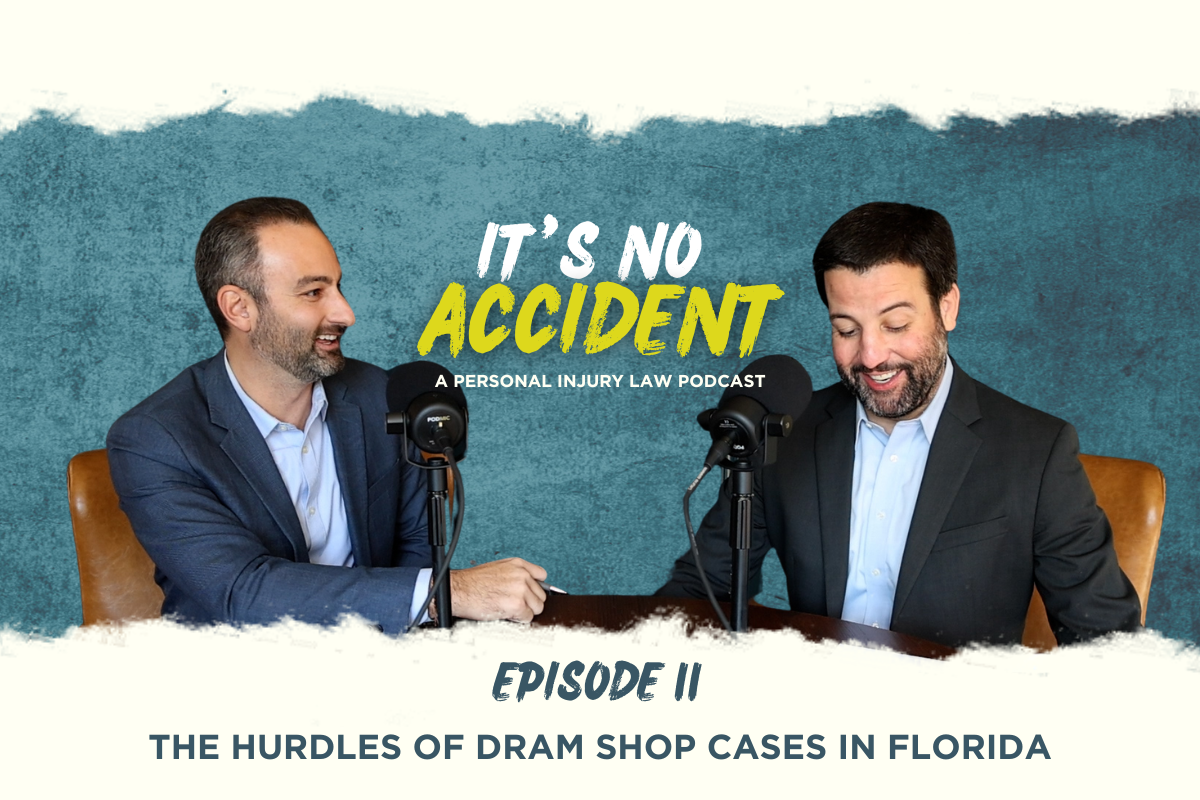
Podcast Description
In episode 11 of It’s No Accident, Mark and Jaeson explore the challenges of handling dram shop cases, where Florida law now holds bars accountable for incidents involving known minors being served underage or habitual alcoholics. The episode features a deep dive into a landmark case from Tallahassee that reached the Florida Supreme Court, shedding light on the nuances of comparative negligence. This episode provides a comprehensive overview of the hurdles in pursuing dram shop cases, changes in the law, and the evidentiary challenges faced by plaintiffs in Florida.
Episode Transcript
Getting into summer, we’re seeing college students returning to school, and with that come recurring legal issues. One major issue we frequently encounter is drunk driving. Unfortunately, it’s not uncommon to see young people drinking and driving, and this brings up various liability concerns.
Over the years, we’ve both handled several such cases, but you’ve dealt with a few more recently, particularly dram shop cases, right?
Yes, exactly. They’re referred to as dram shop cases or liquor liability cases. I’ve handled many of them over the years, although not as many lately due to how challenging the legal landscape in Florida has become. The law makes it very difficult to prove liability in these cases.
Currently, I have one active case I can’t discuss in detail, but here’s the basic framework: Under Florida common law, bars generally aren’t liable for serving alcohol to someone, even if that person later causes injury. However, the Florida Legislature created two exceptions to this rule.
The first exception is when a bar willfully serves alcohol to a known underage individual. If that minor gets injured or causes injury, the bar can be held responsible. The second is if the bar knowingly serves someone who is a habitual alcoholic. If that person harms themselves or someone else, the bar may be liable.
Many people assume that if someone is obviously drunk and gets served, the bar should be held accountable. But unless the individual was underage or a known alcoholic, there typically isn’t a case. And the law has only made it more difficult to bring these cases forward, with increasingly strict evidentiary standards.
The leading dram shop case in Florida recently came out of Tallahassee and made it to the Florida Supreme Court. The core issue was comparative negligence. In that case, a girl was hit by a drunk driver who had been served while underage. However, she had also been drinking. The trial court didn’t allow the jury to consider her intoxication, focusing instead on the drunk driver and the bar’s responsibility under the dram shop law. The law is meant to protect individuals like her.
The Florida Supreme Court disagreed. They ruled that the jury should have been informed of her intoxication and allowed to consider her comparative negligence in determining fault. This decision overturned a multi-million-dollar verdict, sending the case back to square one after nearly a decade of litigation.
It’s a prime example of what we always tell clients: even if you win at trial, the legal journey might not end there. Appeals take years, and during that time, no compensation is awarded. It’s expensive and time-consuming, and the bigger the verdict, the more likely it is to be appealed.
Back to dram shop laws—the two key ways to hold a bar accountable are serving a known habitual drunk or knowingly serving an underage person. Of the two, the habitual drunk standard is much harder to prove. Unless the person outright admits they had a problem, it’s tough. I remember a case you handled where the defendant admitted during a deposition from prison that he had a problem and was now in treatment. That kind of admission is rare.
Families often protect the individual, denying there’s a problem even when there are multiple DUIs and a clear pattern of alcohol abuse. I had a case where the driver rear-ended my client at 5 p.m. and had a blood alcohol content five to six times the legal limit. The officer who interacted with her said she seemed completely normal, which is a strong indicator of long-term alcohol abuse. Still, proving it is extremely difficult.
As for fake IDs, if a minor uses one and the bar checks it, the law gives the bar a presumption of non-liability. However, if it can be shown that the bar knew or should’ve known the ID was fake, that presumption can be rebutted. We all know how things work in college towns. If a kid knows someone at the door, it’s easier to get in, fake ID or not.
Some bars don’t even pretend to enforce ID checks. I had a case where a girl died after being served at a local bar. On social media, the bar and its third-party promoters posted things like “Come drink until you can’t see straight.” During depositions, the promoter, now with a family of his own, broke down when asked to read his own posts. These are tough cases emotionally and legally.
We see repeat offenders in Tallahassee. Some bars are known for underage drinking, and while the public might know, proving it in court is another story. Staff rarely testify against their employers, and bar owners deny wrongdoing. These are challenging cases from every angle.
That said, there are good examples, like Bullwinkle’s. It’s almost impossible for underage individuals to get in. They have strict ID checks and even law enforcement on-site. If more bars followed their lead, it would reduce these tragic incidents significantly.


